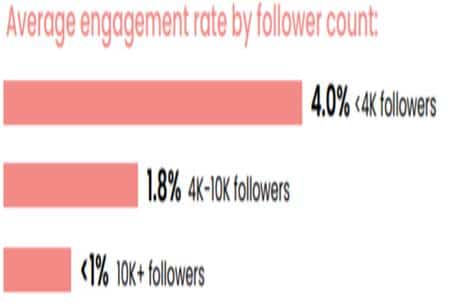Are you planning to launch an eCommerce influencer marketing campaign? Good plan!
Social media influencers can drive your eCommerce sales through the roof. Why so?
Because influencers foster consumer trust, which is an essential driving force behind most purchase decisions.
Additionally, they boost brand awareness and reach, which can be game-changers in the competitive eCommerce industry.
In fact, 58% of consumers have purchased a product on an influencer’s recommendation.

Image via Edelman
If your eCommerce influencer marketing campaign is not increasing your sales, awareness, or authority as desired, there’s obviously something wrong that you’re doing.
So, take a good look at your influencer marketing strategy and figure out what’s wrong with it.
To help you out, I’ve listed four of the most common mistakes eCommerce marketers commit while planning, building, and executing influencer marketing campaigns.
Maybe, you’re guilty of making these same mistakes too.
If so, fret not. Just implement the fixes I’ve discussed with these mistakes and accelerate your eCommerce influencer marketing campaign.
So, let’s dive right in.
4 Common Mistakes (and Fixes) to Avoid in Your Ecommerce Influencer Marketing Campaign

If you’re getting insufficient results from your eCommerce influencer marketing campaign, perhaps you’re guilty of committing one or more of the mistakes below:
Recommended for you: 7 Killer ECommerce Marketing Strategy to Boost Your Business.
1. Unclear Campaign Goals
Clearly defined goals are a must for any kind of marketing campaign, including influencer-led ones.
If your eCommerce influencer marketing campaign lacks proper goals and metrics, you won’t be able to gauge its performance accurately. Neither will you be able to justify your marketing spend in this direction.

Anything else?
Yes. Without clear goals in sight, your influencer marketing team might just end up spending all their time, effort, and resources pursuing wrong strategies.
When you have concrete goals to achieve, your eCommerce influencer marketing campaign gets a sense of direction.
Together, you and your influencers can formulate action plans and strategies to meet your campaign goals in a time-bound manner.
In a nutshell, goals will govern all your campaign variables – from the kind of influencers you hire to the tactics, metrics, and platforms you choose to target.
How to Fix This Mistake?
Before you launch an eCommerce influencer marketing campaign, invest time in defining its goals and objectives.
Analyze what is most important for you – increasing sales, driving store traffic, getting referrals, generating great content, or something else.
You can also strive to achieve more than one goal from one eCommerce influencer marketing campaign.
If you’re not sure what kind of things can be achieved through influencer marketing, take a cue from top influencer marketers surveyed by AspireIQ.

Image via AspireIQ
85% of them leverage influencers to boost brand awareness, 64% to generate quality content, and 52% to launch products.
Other common goals include generating sales (50%), solidifying brand reputation (46%), and promoting events (25%).
Pick goals that are aligned with your larger business objectives. Each eCommerce influencer marketing campaign should drive you closer to the goal you had in mind while starting your eCommerce store.
You can also build a step-by-step strategy involving multiple campaigns that lead up to your final goal.
2. Wrong Influencer Selection

No matter how precisely your campaign goals are defined, they won’t be achieved magically. You need well-matched and verified influencers to do the job for you.
Wrong influencer selection is another pitfall that can cost you big bucks and tarnish your brand reputation in the worst case.
So, what kind of influencers should you avoid?
Influencers Who Aren’t True Brand Advocates
Authenticity is the foundation of influencer marketing. And, it matters a lot to 69% of American consumers.
If you partner with influencers who have never used your products or are advocating things that go against your brand image, the association will look fabricated.
The result?
Consumers will not believe your influencer’s product recommendations, let alone share them with their friends and families.
Your influencer will neither drive sales nor awareness – defeating the entire purpose of launching an eCommerce influencer marketing campaign.
In worst cases, you may even have to bear the brunt of public backlash for collaborating with a mismatched or fake influencer.
If you think that’s an exaggeration, check out this example:
Microsoft experienced the worst kind of trolling when they hired Oprah Winfrey to promote their new SURFACE tablet.
All was well until Oprah used an iPad to tweet about the Microsoft product. The tweet went viral instantly among social media users who never miss an opportunity to call out brands for goof ups.

Image via TNW
Influencers with Fake/Passive Followers
It’s true that influencer marketing is largely a numbers game, but that doesn’t mean you select influencers for your eCommerce influencer marketing campaign solely on the basis of their follower counts.
Bear in mind that there are many unscrupulous influencers who buy followers or bots. Such fake followers will neither engage with your content nor improve your sales or traffic.
In fact, the AspireIQ research cited earlier shows that fewer the followers an influencer has, more is the engagement rate for the influencer and the brands they endorse.

Image via AspireIQ
I know it’s easy to be swayed by vanity metrics like follower size and ignore real “influence,” but sometimes you have to pay a huge price for the oversight.
Pepsi learned this lesson the hard way. They collaborated with mega-influencer Kendall Jenner, hoping to cash in on her huge fanbase.
What Pepsi didn’t expect was an epic influencer marketing fail when Kylie leveraged the “Black Lives Matter” crisis for social media promotion. The public didn’t take her insensitivity lightly and trolled Pepsi until they took down the ad.
How to Fix This Mistake?
Since it’s virtually impossible to go through hundreds of influencer profiles to verify their engagement, work experience, and brand affinity, you can hire a professional influencer marketing service for influencer audit.
Most of these service providers have databases of verified influencers in most major niches.
Some of them can even help you with contract negotiation and relationship management, leaving you free to manage other pressing business tasks.
You may like: Unique Tips to Incorporate YouTube Ads in Your Marketing Strategy.
3. Campaign-Unready Website

There are times when your eCommerce store is ill-equipped to handle the flood of traffic that influencers drive through their promotions.
That ends up frustrating visitors who may blacklist your brand or rant about it on public forums – disastrous news for any eCommerce brand.
Worse still, you might end up ruining your influencer relationship for good.
After all, your influencer’s credibility suffers when the brand they’re promoting avidly fails to meet their followers’ expectations.
So, what kind of website flaws do you need to look out for while launching your eCommerce influencer marketing campaign?
No Campaign Landing Page
If your website doesn’t have an exclusive landing page for your eCommerce influencer marketing campaign, you might as well not promote your campaign at all.
Why so?
Because it’s only through a landing page that you can drive users to perform actions like purchasing, subscribing, etc.
In addition, landing pages help with campaign performance tracking and attribution if you use UTM links in them.
Additionally, if you plan to pay a commission to influencers for the sales they generate, landing pages can help you with calculating that as well.
How to Fix This Mistake?
Build a dedicated landing page for your eCommerce influencer marketing campaign using robust landing page builders like Leadpages or Wix.
These platforms have inherent eCommerce functionalities like coupon code generators and countdown timers.
On your landing page, include social proof like testimonials from real customers, especially from the influencer’s followers.
Compelling reviews (like shown below) can help win over new buyers and build credibility for you and your influencer.

Image via Quip
Shopify store owners can use marketing plugins like Nudgify and Product Reviews to share customer experiences directly on their online stores.
What else?
Don’t forget to incorporate opt-in forms in your landing page to collect visitor information.
Leverage your influencer’s goodwill to secure the email addresses of their followers. Then, nurture the followers-turned-visitors into paying customers through enticing personalized emails.
One last thing.
As said before, your eCommerce influencer marketing campaign should boost brand awareness.
For doing that, you need to make your landing pages shareable by using eCommerce plugins.
Mobile-Unfriendly Site
Mobile devices generate nearly 73% of total eCommerce sales, and this percentage is poised to rise even further.
If your eCommerce site is not mobile-optimized, no amount of influencer campaigning can give you the desired sales.
How to Fix This Mistake?
Ensure that your site has a responsive design and quick-loading pages. Also, create many iterations for each page element (menus, buttons, etc.), test each iteration on different screen sizes and platforms, and pick the ones that render well universally.
4. Lack of Transparency

Another common mistake you need to avoid in your eCommerce influencer marketing campaign is failing to disclose that your influencer’s posts are sponsored.
As said before, authenticity and transparency are of prime importance to modern consumers. Failing to maintain them can be seen as a breach of consumer trust.
There can be serious legal repercussions as well since failing to disclose the partnership goes against the FTC’s policies.
Don’t believe me?
Then, you need to know about the Lord & Taylor FTC violation fiasco. The apparel brand had hired 50 influencers to create sponsored posts for their #DesignLab eCommerce influencer marketing campaign.

Image via Instagram
But they were pulled up by the FTC when their influencers didn’t disclose the partnership in their promotional content.
The FTC considered it like deceptive advertising and pressed a legal case against the brand.
Needless to say, it was a big blow to the brand and its influencers’ credibility.
How to Fix This Mistake?
Before you start an eCommerce influencer marketing campaign, understand the FTC guidelines regarding sponsored social media content.
Ensure that your influencers declare that their content is sponsored and not organic.
They can do so by writing “ad/sponsored/promoted” or similar phrases in their campaign-related posts, images, stories, and videos.
That should be enough to keep your eCommerce influencer marketing campaign on the right side of the law.
You may also like: Why Email Marketing is Still Important and Beneficial?
Ready to Fail-Proof Your Ecommerce Influencer Marketing Campaign?

While there can be many other pitfalls in an eCommerce influencer marketing campaign, I’ve covered the main ones above.
Let me reiterate them once for your benefit. Make sure your campaign goals are well-defined, your influencers are vetted and well-matched, your website is campaign-ready, and you follow the FTC’s rules. Are there any other mistakes that you’ve committed in your eCommerce influencer marketing campaign? How did you tackle them? Comment your answers below.
This article is written by Gaurav Sharma. Gaurav is the founder and CEO of Attrock, a results-driven digital marketing company. Grew an agency from 5-figure to 7-figure revenue in just two years | 10X leads | 2.8X conversions | 300K organic monthly traffic. He also contributes to top publications like HuffPost, Adweek, Business 2 Community, TechCrunch, and more.
 This article is written by Gaurav Sharma. Gaurav is the founder and CEO of
This article is written by Gaurav Sharma. Gaurav is the founder and CEO of 




